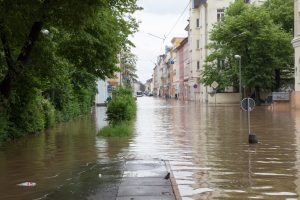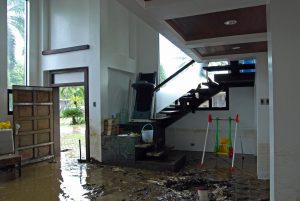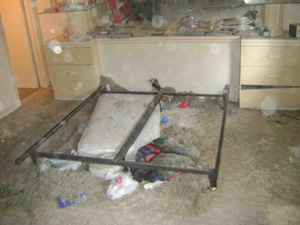Is My House in a Flood Zone?
FloodingFlooding is the overflow or accumulation of water in areas t... More is every homeowner’s nightmare. Not only is human life in danger, but property damage and health risks due to waterborne diseases follow. Homeowners may be forced to evacuate their flooded home, leading to disrupted lives and leaving behind severe destruction that is costly to repairRepair is the act of fixing or restoring damaged property, m... More or replace.
While floodingFlooding is the overflow or accumulation of water in areas t... More is commonly known to result from natural calamities, like overflowing riverbanks or torrential rains, floodingFlooding is the overflow or accumulation of water in areas t... More can also be triggered from inside the home. Ruptured water pipes, basement leaks and faulty bathroom fixtures can deliver a surge of water into your home, leading to precipitous floods.
What is a Flood Zone?

A flood zone is an area with a floodingFlooding is the overflow or accumulation of water in areas t... More risk of at least 1%.
Certain homes may be at greater risk for floodingFlooding is the overflow or accumulation of water in areas t... More caused by natural disasters. These residences are located in what is known as a flood zone. Any home that has a one percent chance of floodingFlooding is the overflow or accumulation of water in areas t... More in any given year is placed in a flood zone. The Federal Emergency Management Agency (FEMA) considers properties at risk for floods to be in a Special Flood Hazard Area (SFHA). FEMA has categorized 20,000 communities in the United States into various flood zones.
The likelihood of your home floodingFlooding is the overflow or accumulation of water in areas t... More is determined by the “100 year” or “500 year” floodplain. A 100-year floodplain has the probability of floodingFlooding is the overflow or accumulation of water in areas t... More one percent annually. The 500-year floodplain has a 1 in 500 chance of floodingFlooding is the overflow or accumulation of water in areas t... More in any given year.
How to Know If Your Property Is In a Flood Zone
Here are several ways to determine if your house is in a flood zone:
- Floodsmart.gov – Online resourcesResources include tools, personnel, equipment, and materials... More, like Floodsmart.gov, offer homeowners a visual picture of whether or not a home rests along a flood zone. Visitors to this site can enter an address and receive specific, instant results. The FEMA Flood Map Service Center can be accessed through the Floodsmart.gov website.
- City Hall – Your town or city hall is staffed with employees who have access to flood zone maps, since the town or city hall is the designated entity that issues local building permits.
- Insurance Agents – Your insurance agent is a well-informed source to help identify whether or not your home is located in a flood zone.
- Realtor – If you are building a new home, your realtor will have knowledge of whether or not the land is deemed at risk for floodingFlooding is the overflow or accumulation of water in areas t... More.
Flood Insurance
Homeowner’s insuranceHomeowner’s insurance is a policy that provides financial ... More policies do not cover floodingFlooding is the overflow or accumulation of water in areas t... More; flood insurance must be purchased separately. The National Flood Insurance Program offers flood insurance to homeowners, and homeowners living in flood zones are advised to protect their assets with flood insurance. Flood insurance can be purchased for $400 per year from the program. However, insurance rates are determined by how likely a home is to undergo a flood. Flood insurance is mandatory when homes are deemed to be at high risk for floodingFlooding is the overflow or accumulation of water in areas t... More.
Several flood zones exist. Each flood zone is given a letter that describes the level of risk for flooding:
V Zones – Beachfront Properties
Homes that dot along the coastline are at the greatest risk for floodingFlooding is the overflow or accumulation of water in areas t... More in comparison to properties in other floodplains. Beachfront residences should be built so the homes are elevated on posts or column foundations and protected from waves, erosion, and hurricane winds. Plus, coastal properties are required to be built with electrical, plumbing, and HVAC equipment that is elevated to or above the base flood elevation.
Flood insurance is mandatory for homes in V zones.
A Zones – Lakeside Homes
Homes located along bodies of water, such as lakes, ponds, and rivers, are categorized as properties in the A zone—the next most hazardous zone after V zones. In such properties, areas below the lowest floors cannot be used as living quarters. Similar to V zones, all electrical, plumbing, and air conditioning/heating units must be located at or above the base flood elevation.
Due to the high risk of floodingFlooding is the overflow or accumulation of water in areas t... More in A zones, insurance is mandatory.
The A zone category features numerous subcategories, such as zone AO (homes located on sloping land and that have a one percent chance of floodingFlooding is the overflow or accumulation of water in areas t... More annually) and zone AH (homes that undergo ponding and have a one percent annual chance of floodingFlooding is the overflow or accumulation of water in areas t... More).
B Zones – Residences with Limited Drainage
Properties built along land with drainage areas under one square mile are considered to be in B zones. These homes have less than a 0.2 percent annual chance of floodingFlooding is the overflow or accumulation of water in areas t... More. B zone homes are also protected from floodingFlooding is the overflow or accumulation of water in areas t... More by embankments.
X Zones and C Zones – Low-risk Properties
Homes that are unlikely to flood are considered to be in X zones or C zones. These homes are considered to be beyond the 1 percent and 0.2 percent chance of annual floodingFlooding is the overflow or accumulation of water in areas t... More.
D Zones – Undetermined Areas
Some properties may be built along land that has not been identified as being in a flood zone. However, D zone homes are still at risk for floodingFlooding is the overflow or accumulation of water in areas t... More; however, the risk level is undetermined.
Numerous additional zone subclassifications exist; these mentioned zones are most predominant.
Flood Cleanup

Be sure to call RestorationMaster immediately if your home is flooded in the Indianapolis, IN area.
Even if your home or business may not be located in a hazardous flood zone, unanticipated floods happen. When your property is devastated by a flood, whether due to a natural disaster or a leak inside the home, contact the area’s most reputable water damage restoration company, RestorationMaster.
The water damage restoration specialists utilize advanced technology and techniques to extract all excess moisture from the home. Even standing water can be effectively removed. The IICRC-certified technicians are also trained to pinpoint the source of the flood and resolve the issue with professionalism and expertise. Finally, they will work with your homeowner’s insuranceHomeowner’s insurance is a policy that provides financial ... More to coordinate claims.
The RestorationMaster team of water damage restorationWater damage restoration is the professional process of clea... More specialists are on call 24 hours a day, 7 days a week, in the event of an emergency. A tiny trickle of water can burst into a mammoth issue in a matter of minutes. As soon as a leak is noticed on your residential or commercial property, contact RestorationMaster in the Indianapolis, IN area to thwart a possible disaster.












